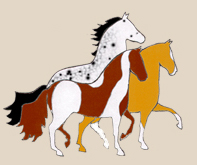 | ||||

For information on registering your Paso horse with Pintado or Atigrado characteristics
Contact us at:.
Welcome to the Official website of the Spanish Jennet Horse and
the Spanish Jennet Horse Society!
Pintado Spanish Jennet
The Pinto Paso Horse
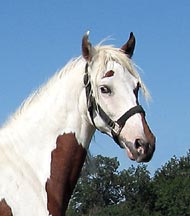
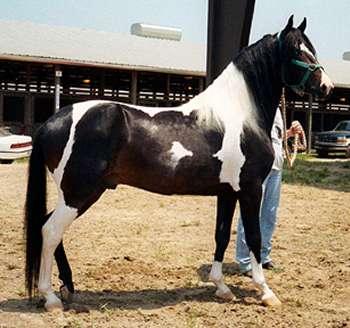
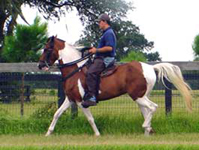

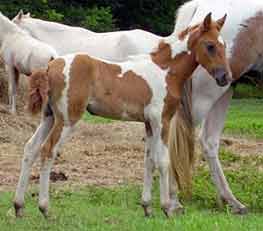
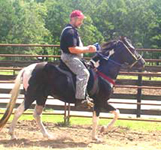
This is the division for pinto patterned Paso or Paso Fino gaited horses called the
Pintado Spanish Jennet. They are purebred, Paso or Paso Fino, gaited, non-gray horses and can be marked with any pinto pattern.
To be eligible for registration a horse must be a purebred Paso or Paso Fino horse registered with one of the approved registries listed below or give proof by genetic parental verification that they are the offspring of registered Paso or Paso Fino horses, or be the genetically verified offspring of registered Spanish Jennet horses.
Non-patterned offspring from these individuals will be registered as Spanish Jennet breeding stock and may be used for either the Pintado or Atigrado division. Additionally, on-patterned non-gray purebred Paso or Paso Fino sires and dams of Pintado Spanish Jennet offspring maybe registered as breeding stock.
While breeding to grey horses to produce Spanish Jennet Horses is discouraged, a Pinto Paso horse whose sire or dam is gray shall be eligible for registration in the Spanish Jennet Horse Society after satisfactory genetic proof is given of the absence of the gray gene. Genetic testing is available for the grey gene.
Approved Registries:
APF
PFHA
AAOBPPH
PPHRNA
PHAC
Guide to the Pintado Spanish Jennet
The division for the pinto Spanish Jennet is called Pintado (Pinto Paso or Pinto Paso Fino) - the Spanish term for pinto. The correct terms for referring to horses in this division is either Pintado (Pinto Paso or Pinto Paso Fino) or pinto. The term “Paint” refers to a blood breed of pinto horses that are descended from Quarter Horses, Thoroughbreds and other Paint horses. It is not correct terminology for the Spanish Jennet. Pintado (Pinto Paso or Pinto Paso Fino) horses have a white pattern on a dark background. The colloquial use of the term "color" to indicate "pattern" is technically incorrect.
Tobiano
This is the color pattern most people think of when you say pinto or Pintado (Pinto Paso or Pinto Paso Fino). Tobiano is a single dominant gene inherited in Mendelian fashion. There are modifying genes which control the extent of the markings, but rely on the presence of the Tobiano gene to be expressed.
Tobiano is a pattern of white spots that appear to spread vertically DOWN from the dorsal line and upward from white legs (almost always 4). Leg markings end in jagged tops (as opposed to the arrow topped markings of the Sabino). Markings may extend down far enough to join the leg markings. Pattern can be quite minimal to very extensive. Tobianos very often are relatively symmetrical from side to side.
Tobiano face markings are like those on solid horses. This is the only pinto pattern that can have a solid head. One or both eyes may be wall-eyed. Even where base color is extremely reduced, some color always remains on the head. Secondary spotting in the form of “ink spots" or "paw prints" maybe seen within the white pattern. There is a high incident of homozygosity in horses with these marks. Chestnuts (on the leg) may have spots over them. Leg markings may have ermine spots and light, dark or bi-colored hooves. The edges of spots may fade or bleed at the edges.
One tobiano parent is required, even if that parent is incompletely marked.
In the homozygous state Tobiano produces 100% Tobiano. Both parents must be Tobiano for an offspring to be homozygous.
Homozygosity can be determined by genetic testing.
Characteristics of the Tobiano
• White markings cross the dorsal line.
• White markings descend vertically.
• White markings with irregular edges on all 4 legs.
• May have ermine spots at coronet and dark or partially dark hooves.
• Head is dark. Eyes dark or blue, or may have flashes of blue in a dark field.
• Neck can be white from the crest down.
• Body has vertical white, with shielded spots of color.
• Legs are white and can have ermine spots or spots around chestnuts.
• Tail is dark or two-tone.
Individuals with exceptions to the list above do occur but they have other feature which identify them as tobiano.
Sabino
Any horse with a chinspot, white on the legs extending above the middle of the knee, or an arrow marking extending up the front of the hock is a genetic Sabino (pronounced sa-bee-no). Sabino may be with or without a belly spot.
Sabino can range from minimal white (legs and chinspot only) to the classic peaked Sabino: markings peak at any or all of these locations: buttocks, hips, ribs, shoulders, neck. Many Sabino horses show extensive ticking (flecking).
Sabino is a dominant trait. But, Sabino to Sabino crosses can produce solid offspring. A Sabino from 2 solid parents is termed a “crop-out”.
Sabino is a pattern of white patches which appear to spread vertically UP from the legs, under the belly and neck.
Sabino face markings are a large blaze and a chinspot. Blue eyes result frequently when the blaze crosses or goes into the eye.
Sabino is frequently confused with overo.
Characteristics of the Sabino
• White spot or spots on the belly, girth area or chest following the underside of the
neck.
• White on the body appears to run vertically up, ending in irregular points or arrows
diminishing in size.
• White chinspot.
• White legs with white hooves OR a minimum of one white leg marking running up
to a point.
• Ticking or roaning.
• Head has white under the jaw or chinspot.
• Neck has a white throat or underside with vertical peaks pointing up.
• Body has vertical white peaks, belly spot and ticking.
• Legs are white with edges pointed up.
• Tail is dark or streaked.
Rount
Heavy ticking can be a form of Sabino known as Rount. This is characterized by a fading or “roaning out”. It is not related to the grey gene. These horses are marked with poorly defined roan and white splotches scattered randomly over the body. The appearance of the animal is either pink or blue depending on the base color of the coat.
Composite Patterns
All pinto patterns are genetically dominant.
The medicine hat is always Sabino but frequently occurs in combination with the Tobiano gene.
Combination breeding frequently produce horses that are a high percentage of white.
Composites are usually high percentage color producers.
